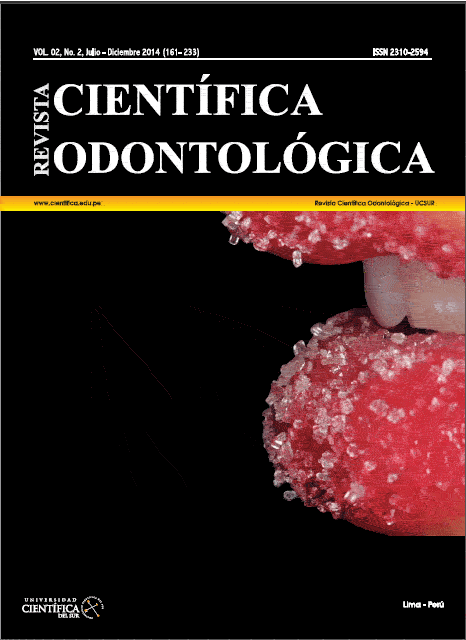Análisis de la vía aérea faríngea en cefalogramas derivados de tomografía computarizada cone beam en sujetos con distinta relación esquelética
DOI:
https://doi.org/10.21142/2523-2754-0202-2014-%25pPalabras clave:
Imágenes, Faringe, Vía área faríngea, Tomografía Computarizada de Haz CónicoResumen
OBJETIVO: Comparar las dimensiones del espacio aéreo faríngeo en individuos adolescentes y adultos con diferentes
patrones esqueléticos antero posteriores utilizando cefalogramas derivados de Tomografía Computarizada Cone Beam
(TCCB).
METODOLOGÍA: Se obtuvieron registros tomográficos de 48 sujetos (25 hombres y 23 mujeres) entre 16 y 39 años de edad, se conformaron tres grupos de acuerdo al ángulo ANB de Steiner clasificados como: Sujetos de Clase I, II, ó III. Cuatro medidas lineales a nivel de la faringe fueron analizadas tomando como referencia en el maxilar superior el punto A y el punto incisivo central superior ICS y en el maxilar inferior el punto B y el punto Pogonion blando Pgb.
RESULTADOS: Las pruebas de ANOVA y de Tukey fueron utilizadas para establecer las comparaciones entre las dimensiones de la faringe y la clase esquelética. Se encontró que el diámetro de la faringe medida a nivel del punto A (OFA) fue el único estadísticamente significativo (p=0.044) estando aumentado en el grupo de Clase II.
CONCLUSIÓN: La única dimensión aumentada en la faringe está en el maxilar superior a nivel del punto A en sujetos
de Clase II, revelando que el espacio aéreo faríngeo no siempre se ve afectado por los diferentes patrones esqueléticos.
Descargas
Referencias
Ricketts RM. Respiratory obstruction syndrome. Am J Orthod 1968; 54:495-507
Linder-Aronson S. Adenoids. Their effect on mode of breathing and nasal airflow and their relationship to characteristics of the facial skeleton and the dentition. A biometric, rhino-manometric and cephalometro-radiographic study on children with and without adenoids. Acta Otolaryngol Suppl 1970; 265:1-132
Lamichane M, Anderson NK, Rigali PH, Seldin EB, Will LA.Accuracy of reconstructed images from cone-beam computed tomography scans. Am J Orthod Dentofacial Orthop 2009; 136: 156.e1-6: discussion,
-7
Aboudara C, Nielsen I, Huang J, Maki K, Miller A, Hatcher D. Comparison of airway space with conventional lateral headfilms and 3 – dimensional reconstruction from cone- beam computed tomography. Am J Orthod Dentofacial Orthop.2009; 135:468-79
Yamashina A, Tanimoto K, Sutthiprapaporn P, Hayakawa Y. The reliability of computed tomography (CT) values and dimensional measurements of the oropharyngeal region using cone beam CT: comparison with multidetector CT. Dentomaxilofacial Radiology.
, 37: 245–251 6 Steiner C. Cephalometric for you and me. Am J Orthod Dentofacial Orthop. 1954; 39:729-55.
Tso H, Lee J, Huang J, Maki K, Hatcher D, Miller A. Evaluation of the human airway using cone-beam computerized tomography. Oral Surg Oral Med Oral Pathol Oral Radiol Endod 2009; 108:768-776
Iwasaki T, Hayasaki H, Takemoto Y, Kanomi R, Yamasaki Y. Oropharyngeal airway in children with Class III malocclusions evaluated by cone-beam computed tomography. Am J Orthod Dentofacial Orthop 2009; 36:318
Grauer D, Cevidanes L, Styner M, Ackerman J, Proffit W. Pharyngeal airway volume and shape from Cone-beam computed tomography: Relationship to facial morphology. Am J Orthod Dentofacial Orthop 2009; 136:805-14
Kim Y, Hong J, Hwang Y, Park Y. Three-dimensional analysis of pharyngeal airway in preadolescent children with different antero posterior skeletal patterns. Am J Orthod Dentofacial Orthop 2010; 137:306
Alves M, Baratieri C, Nojima L, Nojima M, Ruelas A. Universidad Científica del Sur Revista Científica Odontológica. 2014;2(1):183-189
Three-dimensional assessment of pharyngeal airway in
nasal and mouth-breathing children. International Journal of Pediatric Otorhinolaryngology 72011;75:1195-99.
Iwasaki T, Saitoh Y, Takemoto Y, Inada E, Kanomi R, Hayasaki H, Yamasaki Y. Evaluation of upper airway obstruction in Class II children with fluid - mechanical simulation. Am J Orthod Dentofacial Orthop
;139:e135-e145
Hernandez F, Guijarro R, Mareque J. Effect of Monoand Bimaxillary Advancement on Pharyngeal Airway Volume: Cone-Beam Computed Tomography EvaIuación. J Oral Maxillofac Surg 69: e395-e400, 2011
Hong J, Min Oh K, Kim Bo, KimY, Park Y. Three-dimensional analysis of pharyngeal airway volume in adults with anterior position of the mandible. Am J Orthod Dentofacial Orthop 2011; 140:e161-e169.
Alves Jr M, Franzotti E, Baratieri C, Nunes L, Ruelas A. Evaluation of pharyngeal airway space amongst different skeletal patterns. J. Oral Maxillofac. Surg. 2012; 41: 814–819.
Kumar V, Ludlow J, Soares Cevidanes L, Mol A. In Vivo Comparison of conventional and Cone Beam CT Synthesized Cephalograms. Angle Orthodontist, Vol 78, No 5, 2008.
Cattaneo, P, Borgkvist Bloch C,CalmarD, Hjortshøj M. Melsen B. Comparison between conventional and cone-beam computed tomography–generated cephalograms. Am J Orthod Dentofacial Orthop 2008;134:798-802
Moshiri M, Scarfe W, Hilgers M ,Scheetz J, Silveira A, Farman A. Accuracy of linear measurements from imaging plate and lateral Cephalometric images derived from cone-beam computed tomography. Am J Orthod Dentofacial Orthop 2007; 132:550-60
O’Ryan FS, Gallagher DM, LaBanc JP, Epker BN. The relation between nasorespiratory function and dentofacial morphology: a review. Am J Orthod. 1982 Nov; 82(5):403-10.
Sutthiprapaporn P, Tanimoto K, Ohtsuka M, Nagasaki T, Iida Y, Kat-sumata A. Positional changes of oro-pharyngeal structures due to gravity in the upright and supine positions. Dentomaxillofac Radiol 2008: 37: 130–135.
El H, Palomo JM. Measuring the airway in 3 dimensions: a reliability and accu- racy study. Am J Orthod Dentofacial Orthop 2010: 137: S50 e51–Se59
Tso H, Lee J, Huang J, Maki K, Hatcher D, Miller A. Evaluation of the human airway using cone-beam computerized tomography. Oral Surg Oral Med Oral Pathol Oral Radiol Endod 2009; 108:768-776
Grauer D, Cevidanes L, Styner M, Ackerman J, Proffit W. Pharyngeal airway volume and shape from Cone-beam computed tomography: Relationship to facial morphology. Am J Orthod Dentofacial Orthop 2009; 136:805-14
Kim Y, Hong J, Hwang Y, Park Y. Three-dimensional analysis of pharyngeal airway in preadolescent children with different antero posterior skeletal patterns. Am J Orthod Dentofacial Orthop 2010; 137:306
Hong J, Min Oh K, Kim Bo, KimY, Park Y. Three-dimensional analysis of pharyngeal airway volume in adults with anterior position of the mandible. Am J Orthod Dentofacial Orthop 2011; 140:e161-e169.
Iwasaki T, Saitoh Y, Takemoto Y, Inada E, Kanomi R, Hayasaki H, Yamasaki Y. Evaluation of upper airway obstruction in Class II children with fluid - mechanical simulation. Am J Orthod Dentofacial Orthop 2011; 139:e135-e145.
Descargas
Publicado
Número
Sección
Licencia

Este obra está bajo una licencia de Creative Commons Reconocimiento 4.0 Internacional.












